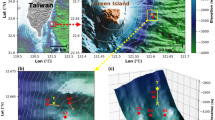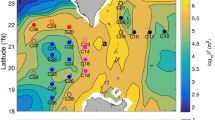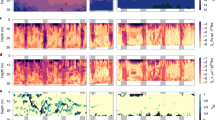Abstract
Turbulence in shelf seas strongly affects the spread of pollution (such as oil spills1) as well as the distribution of sediment2 and phytoplankton blooms3. Turbulence is known to be generated intermittently close to the sea bed4, but little is known of its evolution through the water column, or to what extent it affects the surface. Here we present observations of the surface effects of bottom-generated turbulence in a tidally influenced and well mixed region of the North Sea, as derived from acoustic and visual images. Although the sea bed in the area is flat, we find that at any one time, 20–30% of the water surface is affected by boils—circular regions of local upwelling—of diameter 0.9±0.2 times the water depth. The signature of individual boils persists for at least 7 minutes and, in accordance with laboratory5,6 and numerical7 studies, shows the appearance of eddies. The boils contribute to the replacement of surface waters from depth in unstratified waters, and may therefore enhance the fluxes of gases between atmosphere and ocean.
This is a preview of subscription content, access via your institution
Access options
Subscribe to this journal
Receive 51 print issues and online access
$199.00 per year
only $3.90 per issue
Buy this article
- Purchase on Springer Link
- Instant access to full article PDF
Prices may be subject to local taxes which are calculated during checkout




Similar content being viewed by others
References
Murray, S. P. Turbulent diffusion of oil in the ocean. Limnol. Oceanogr. 17, 651–660 (1972).
Jago, C. F. & Jones, S. E. Observation and modelling of the dynamics of benthic fluff resuspended from a sandy bed in the southern North Sea. Continent. Shelf Res. 18, 1255–1282 (1998).
Tett, P. B. et al. Biological consequences of tidal stirring gradients in the North Sea. Phil. Trans. R. Soc. Lond. A 343, 493–508 (1993).
Heathershaw, A. D. “Bursting” phenomena in the sea. Nature 248, 394–395 (1974).
Komori, S., Murakami, Y. & Ueda, H. The relationship between surface renewal and bursting motions in an open channel flow. J. Fluid Mech. 203, 103–123 (1989).
Kumar, S., Gupta, R. & Banerjee, S. An experimental investigation of the characteristics of free-surface turbulence in channel flow. Phys. Fluids 10, 437–456 (1998).
Tsai, W. T. Anumerical study of the evolution and structure of a turbulent shear layer under a free surface. J. Fluid Mech. 354, 239–276 (1998).
Kawanisi, K. & Yokosi, S. Mean and turbulence characteristics in a tidal river. Estuar. Coast. Shelf Sci. 38, 447–469 (1994).
Thorpe, S. A. & Hall, A. J. The characteristics of breaking waves, bubble clouds, and near-surface currents using side-scan sonar. Continent. Shelf Res. 1, 353–384 (1983).
Belloul, M. B. & Thorpe, S. A. Acoustic observation of oil slicks at sea. J. Geophys. Res. 97, 5215–5220 (1992).
Farmer, D. M. & Li, M. Patterns of bubble clouds organized by Langmuir circulation. J. Phys. Oceanogr. 25, 1426–1440 (1995).
Thorpe, S. A., Cure, M. S., Graham, A. & Hall, A. J. Sonar observations of Langmuir circulation and estimation of dispersion of floating particles. J. Atmos. Ocean. Technol. 11, 1273–1294 (1994).
Thorpe, S. A., Ulloa, M. J., Baldwin, D. & Hall, A. J. An autonomously recording inverted echo sounder; ARIES II. J. Atmos. Ocean. Technol. 15, 1346–1360 (1998).
Simpson, J. H. The shelf-sea fronts: implications of their existence and behaviour. Phil. Trans. R. Soc. Lond. A 302, 531–546 (1981).
Graham, A. & Hall, A. J. The horizontal distribution of bubbles in a shallow sea. Continent. Shelf Res. 17, 1051–1082 (1997).
Thorpe, S. A. On the clouds of bubbles formed by breaking wind-waves in deep water, and their role in air-sea gas transfer. Phil. Trans. R. Soc. Lond. A 304, 155–210 (1982).
Stommel, H. Trajectories of small bodies sinking slowly through convection cells. J. Mar. Res. 8, 24–29 (1949).
Thorpe, S. A. The effect of Langmuir circulation on the distribution of submerged bubbles caused by breaking wind waves. J. Fluid Mech. 142, 151–170 (1984).
Jackson, R. G. Sedimentological and fluid dynamic implications of the turbulent bursting phenomenon in geophysical flows. J. Fluid Mech. 77, 531–560 (1976).
Longuet-Higgins, M. S. Surface manifestations of turbulent flow. J. Fluid Mech. 308, 15–29 (1996).
Hunt, J. C. R. & Graham, J. M. R. Free stream turbulence near plane boundaries. J. Fluid Mech. 84, 209–235 (1978).
Banerjee, S. Upwellings, downdrafts, and whirlpools: dominant structures in free surface turbulence. Appl. Mech. Rev. 47, S166–S172 (1994).
Schröder, M. & Siedler, G. Turbulent momentum and salt transport in the mixing zone of the Elbe Estuary. Estuar. Coast. Shelf Sci. 28, 615–638 (1989).
Baumert, H. & Radach, G. Hysteresis of turbulent kinetic energy in nonrotational tidal flows: a model study. J. Geophys. Res. 97, 3669–3677 (1992).
Bowden, K. F. Horizontal mixing in the sea due to a shearing current. J. Fluid Mech. 21, 83–95 (1965).
Fischer, H. B. Longitudinal dispersion and turbulent mixing in open channel flow. Annu. Rev. Fluid Mech. 5, 59–78 (1973).
Nimmo Smith, W. A. M. & Thorpe, S. A. Dispersion of buoyant material by Langmuir circulation and a tidal current. Mar. Pollut. Bull. (in the press).
Ridderinkhof, H. & Zimmerman, J. T. F. Chaotic stirring in a tidal system. Science 258, 1107–1111 (1992).
Woolf, D. K. & Thorpe, S. A. Bubbles and the air-sea exchange of gases in near-saturation conditions. J.Mar. Res. 49, 435–466 (1991).
Acknowledgements
We thank T. Lunnel (AEA Tech. plc) for providing the video of the oil slick and the environmental data for the CASI images. We also thank the Environment Agency for supplying the CASI images, and V. Byfield for calibrating them; and A. Hall for help in collecting the sonar data. The observations in the North Sea were funded by an EEC MAST contract. W.A.M.N.S. is supported by NERC.
Author information
Authors and Affiliations
Corresponding author
Rights and permissions
About this article
Cite this article
Smith, W., Thorpe, S. & Graham, A. Surface effects of bottom-generated turbulence in a shallow tidal sea. Nature 400, 251–254 (1999). https://doi.org/10.1038/22295
Received:
Accepted:
Issue Date:
DOI: https://doi.org/10.1038/22295
This article is cited by
-
Localised anthropogenic wake generates a predictable foraging hotspot for top predators
Communications Biology (2019)
-
Orientation and food search behaviour of a deep sea lobster in turbulent versus laminar odour plumes
Helgoland Marine Research (2017)
-
Thermal and dynamic surface signatures of the wake of a submerged sphere
Journal of Visualization (2009)
-
Eddy generation in the tidal Potomac River
Estuaries and Coasts (2006)
Comments
By submitting a comment you agree to abide by our Terms and Community Guidelines. If you find something abusive or that does not comply with our terms or guidelines please flag it as inappropriate.



